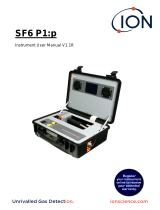Page is loading ...

A 400
A 400
10
mbar mbar.l/s
-3 10-12
10-11
10-10
10-9
10-8
10-7
10-6
10-5
10-4
10-3
10-2
10-2
10-1
1
101
102
103
CYCLE
INLET
VENT
SNIF
HIGH
TEST
ZEROCOR
AUTO CAL ZERO
START
STAND-BY
OPERATOR INTERFACE
APPLICATION WINDOWS
ASSISTANCE TO THE TEST
MAIN FONCTIONS
CONDENSED MANUAL
ASM 310
References refer to a specific chapter of the
User’s Manual.
For further information, please refer to the User’s Manual
supplied with your unit.
Change the application
window (come back to
home).
Change the level.
Start the function
allocated.
Application window
(touch-sensitive screen)
1
2
3
4
5
6
1
Function keys allowing the
activation of the associated
functions.
2
Functions allocated to the function
keys.
3Start/Stop of a test.
4Level change.
5
Application window change,
come back to home (standard
display).
6Remote control connection
(accessory).
Start/Stop the test
Place the blank-off fl ange on the detector
inlet (detector state on delivery).
START
STAND-BY
Start the test.
The helium signal displays the
measured value : it corresponds in our
case to the detector background.
START
STAND-BY
Stop the test.
To remove the blank-off flange, do an
air inlet.
Set Points C 401
2 adjustable set points:
reject set point in hard vacuum,
reject set point in sniffing.
Define the acceptance threshold of the good/bad parts:
leak value measured ≤ reject set point => part accepted.
leak value measured > reject set point => part rejected.
Audio alarm set points C 401
Digital voice informs the operator about the detector state or the actions to do.
The audio alarm informs the operator that the reject set point was crossed. The level
varies from 0 to 8 (0 to 90 dB).
or
Stop simultaneously the audio alarm and the digital voice with the key .
Autocalibration C 406
It allows to check that the detector is adjusted to detect the selected tracer gas and dis-
play a correct leak value.
By default, autocalibration is set ON and the internal calibrated leak is selected to allow
a quick leak detector autocalibration.
Autocal = ON : the detector will be automatically calibrated at each switching on.
At any time, the operator can start an autocalibration ( ).
Remote control
(accessory not
delivery)
Sniffer probe
(accessory
not delivery)
Main power cable
Main power switch
Power fuse + exchange fuse
Inlet vent
and neutral
gas purge
Printer
(not delivered, payable
by the customer)
Exhaust connector
(with silencer)
SD card
SD card
or
Inlet DN 25
External control
system
(I/O interface)
SubD 15 pins
Controlling the detector
with a PC through
the RS 232 interface
(PC not included, payable
by the customer)
Hard vacuum test mode Sniffi ng test mode
Select the hard vacuum
test mode ( C 402)
Select the sniffing test
mode ( C 402)
Connect the part to be tested to the leak
detector inlet port or put the part in the test
chamber connected to the leak detector.
While the leak detector is in stand-by,
connect the sniffer probe (accessory to be
purchased separately) to the sniffer port of
the leak detector.
Select the reject point ( C 401)
STAND-BY
START
Start the test
The leak value measured displays.
STAND-BY
START
Stop the test
The detector returns automatically to stand-by mode.
If Memo function is activated and a printer is connected to the detector,
a test ticket will be printed automatically after the test ( C 406)
Setting Allows the operator to set/
confi gure the detector
according ti its needs
Graphic
display
Allows the operator to follow
and to record the He signals
and the pressure according
to time
Standard
display Inform the operator
of the test
Vacuum
circuit
Indicate to the operator the leak
detector vaccum circuit as well
as the valves state
The operator can mask, add,
switch some windows
in the loop C 403.
The operator can have only
a single application window
displayed.
DETECTOR CONNECTIONS
Do not seal
Do not seal
CAUTION
CAUTION

INLETS / OUTPUTS
INTERVAL MAINTENANCE OPERATIONS
«SETTING» MENUS ARBORESCENCE
CS : Please contact Customer Service
(1) running time
(2) running time or storage
(3) storage
* Service intervals: The service intervals given are for applications and work rates which conform
to the normal operating conditions. If the machine is operating under more
difficult conditions they can be shortened.
Connector
The connector wiring Sub D 15 pin male is delivered with the leak
detector. It is recommended to use a shielded cable which is grounded
on the connector cap.
915
18
14
Inputs
14 Starting-up cycle
Outputs
9 Analog output 16 bit 0/10 V (mantissa)
10 Analog output 16 bit 0/10 V (exponent)
8 Loudspeaker +
15 Loudspeaker -
FREQUENCY*OPERATIONS SEE SHEET
1 000 H(1) Clean filters (inlet filters, air inlet filter). -
4 000 H(1) or
6 months(2)
Clean the vacuum lines, the valves and the
gauges with alcohol - Dust the electronic
boards and the fans. Partial maintenance
of the analyzer cell. Clean the analyzer cell
with alcohol (this cleaning may be necessary
in case of general internal contamination
creating insulating deposits).
E 430
Pirani gauge adjustment. C 406
8 000 H(1)
or 1 year(2) Sniffer probe filter replacement if used. G 200
15 000 H(1) MD1 pump: replacement of membranes and
check valves. E 710
15 000 H(1) Replace the ball bearings of the ATH 31
pump. CS
15 000 H(1)
or 2 years(3)
Recalibration/exchange of the internal
calibrated leak or calibrated leak used for
calibration. E 413
500 000
cycles Change the valves. E 530
Every
2 years Change ATH 31 pump ball bearings if the leak
detector has not been used. CS
NS_03701_EN_05
Pfeiffer Vacuum GmbH
Pfeiffer Vacuum GmbH
Headquarters
Headquarters
T +49 6441 802-0
T +49 6441 802-0
www.pfeiffer-vacuum.com
www.pfeiffer-vacuum.com
/





